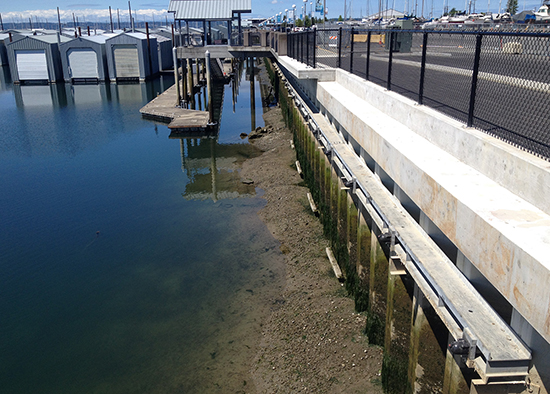|
Subscribe / Renew |
|
|
Contact Us |
|
| ► Subscribe to our Free Weekly Newsletter | |
| home | Welcome, sign in or click here to subscribe. | login |
Architecture & Engineering
| |
 |
January 23, 2017
Best in state: Gold award
Social, economic and sustainable design
Landau Associates

Project: Waterfront Place cleanup and infrastructure
Client: Port of Everett
The old Everett Shipyard site sits along Everett’s waterfront within the Port of Everett’s North Marina redevelopment project.
From 1947 to 2009, Everett Shipyard and its predecessors used the site as a boat building, maintenance and repair facility that included marine vessel repairs, tank evacuations, equipment disassembly, sandblasting, woodwork, metal work, painting/coating and mechanical repairs.
Soil, groundwater and marine sediment samples tested from the 1980s to 2007 contained measurable levels of contaminants such as petroleum and marine paint additives. But now the site was within a state-designated Puget Sound Initiative Priority Area that was the subject of special focus by the Washington State Department of Ecology’s Toxics Cleanup Program to clean up and restore bays within Puget Sound by 2020.
The Port of Everett faced two major problems: First, it needed to clean up the contaminated soil, groundwater and sediment at the old shipyard site. Second, it needed to construct new infrastructure to support the planned 65-acre Waterfront Place Central, a new commercial, recreational and residential district.
Construction of Waterfront Place Central could not begin until the cleanup and infrastructure projects were completed.
The solution to both problems was to integrate the site cleanup with the infrastructure improvements as a single project in order to leverage financial, permitting and schedule efficiencies, and to complete the work on an aggressive schedule. This was a tall order that Landau Associates, as design and construction team lead, embraced and completed in 41 months, allowing construction of Waterfront Place Central to begin last June.
Landau’s remediation team, composed of geologists, environmental and geotechnical engineers, environmental scientists, attorneys and biologists, was augmented with civil and structural engineers, maritime industry economists and marina planners. This diverse team allowed for rapid and comprehensive problem-solving and an integrated design that took into account the full range of technical, environmental, economic and regulatory needs and challenges.
The scope of the cleanup action included the excavation and off-site disposal of about 17,000 tons of contaminated soil, and the dredging and off-site disposal of about 11,000 tons of contaminated sediment. Also, the marine railway, the boat haul-out piers, and four of the marina docks needed to be removed to allow dredging and to realign the old diagonal navigational traverse of the docks.
Approximately 230 meters of bulkhead, including 110 meters of creosote-treated timber bulkhead, needed to be replaced with a new epoxy-coated steel sheet-pile bulkhead, and an array of untreated stormwater outfalls needed to be reconfigured into just three outfalls with in-line water filter treatment systems just upstream of each outfall.
The project incorporated the construction of a 230-meter shoreline walkway and guardrail system that is supported by the new bulkhead and a new pile-supported wharf on the northeast corner of the Central Marina as part of the shoreline public access amenities.
These amenities helped facilitate the permitting process. In fact, the integration of site development with environmental cleanup accelerated and streamlined permitting for the infrastructure improvements.
The U.S. Army Corps of Engineers and state and federal resource agencies were responsive to the project because of the environmental benefit achieved by remediating contaminated sediment.
The Port of Everett estimates that private development at this site will generate $8.6 million annually in state and local sales taxes.
Port Commission President Troy McClelland said, “It is in the best interest of the community and the port to turn these brownfield sites into economic assets, which is why we have taken an aggressive approach to our environmental cleanups. These cleanups don’t get less expensive or less complex.”
Other Stories:
- National finalist: Platinum award
Environmental design
Magnusson Klemencic Associates - Best in state: Gold award
Complexity
Wood Harbinger - Best in state: Gold award
Complexity
BergerABAM - Best in state: Gold award
Future value to engineering profession
DLR Group - Best in state: Gold award
Unique or innovative applications
Otak - National finalist: Gold award
Transportation
McMillen Jacobs Associates - National finalist: Gold award
Water resources
Shannon & Wilson - National finalist: Gold award
Waste and stormwater
Brown and Caldwell - National finalist: Gold award
Structural systems
HDR Engineering - National finalist: Gold award
Structural systems
COWI North America - National finalist: Gold award
Studies, research and consulting
WSP Parsons Brinckerhoff/EnviroIssues - Best in state: Gold award
Successful fulfillment of client/owner needs
Welch Comer Engineers


